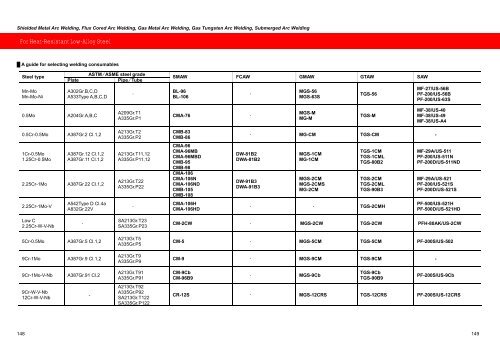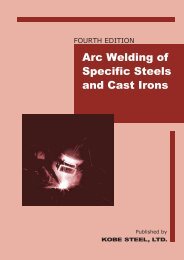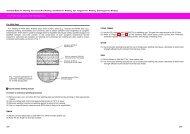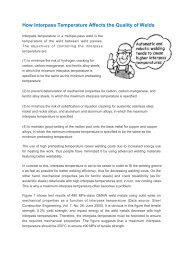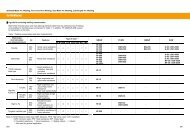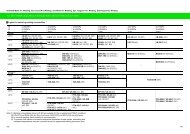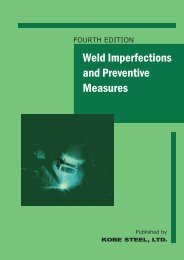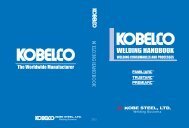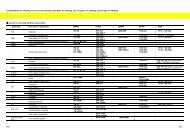For Heat-Resistant Low-Alloy Steel - Kobe Welding (Singapore)
For Heat-Resistant Low-Alloy Steel - Kobe Welding (Singapore)
For Heat-Resistant Low-Alloy Steel - Kobe Welding (Singapore)
You also want an ePaper? Increase the reach of your titles
YUMPU automatically turns print PDFs into web optimized ePapers that Google loves.
Shielded Metal Arc <strong>Welding</strong>, Flux Cored Arc <strong>Welding</strong>, Gas Metal Arc <strong>Welding</strong>, Gas Tungsten Arc <strong>Welding</strong>, Submerged Arc <strong>Welding</strong><strong>For</strong> <strong>Heat</strong>-<strong>Resistant</strong> <strong>Low</strong>-<strong>Alloy</strong> <strong>Steel</strong>█ A guide for selecting welding consumables<strong>Steel</strong> typeMn-MoMn-Mo-NiPlateA302Gr.B,C,DA533Type A,B,C,DASTM ⁄ ASME steel gradePipe ⁄ Tube-SMAW FCAW GMAW GTAW SAWBL-96BL-106-MGS-56MGS-63STGS-56MF-27/US-56BPF-200/US-56BPF-200/US-63S0.5MoA204Gr.A,B,CA209Gr.T1A335Gr.P1CMA-76 -MGS-MMG-MTGS-MMF-38/US-40MF-38/US-49MF-38/US-A40.5Cr-0.5MoA387Gr.2 Cl.1,2A213Gr.T2A335Gr.P2CMB-83CMB-86- MG-CM TGS-CM -1Cr-0.5Mo1.25Cr-0.5Mo2.25Cr-1MoA387Gr.12 Cl.1,2A387Gr.11 Cl.1,2A387Gr.22 Cl.1,2A213Gr.T11,12A335Gr.P11,12A213Gr.T22A335Gr.P22CMA-96CMA-96MBCMA-96MBDCMB-95CMB-98CMA-106CMA-106NCMA-106NDCMB-105CMB-108DW-81B2DWA-81B2DW-91B3DWA-91B3MGS-1CMMG-1CMMGS-2CMMGS-2CMSMG-2CMTGS-1CMTGS-1CMLTGS-80B2TGS-2CMTGS-2CMLTGS-90B3MF-29A/US-511PF-200/US-511NPF-200D/US-511NDMF-29A/US-521PF-200/US-521SPF-200D/US-521S2.25Cr-1Mo-VA542Type D Cl.4aA832Gr.22V-CMA-106HCMA-106HD- - TGS-2CMHPF-500/US-521HPF-500D/US-521HD<strong>Low</strong> C2.25Cr-W-V-Nb-SA213Gr.T23SA335Gr.P23CM-2CW - MGS-2CW TGS-2CW PFH-80AK/US-2CW5Cr-0.5MoA387Gr.5 Cl.1,2A213Gr.T5A335Gr.P5CM-5 - MGS-5CM TGS-5CM PF-200S/US-5029Cr-1MoA387Gr.9 Cl.1,2A213Gr.T9A335Gr.P9CM-9 - MGS-9CM TGS-9CM -9Cr-1Mo-V-NbA387Gr.91 Cl.2A213Gr.T91A335Gr.P91CM-9CbCM-96B9- MGS-9CbTGS-9CbTGS-90B9PF-200S/US-9Cb9Cr-W-V-Nb12Cr-W-V-Nb-A213Gr.T92A335Gr.P92SA213Gr.T122SA335Gr.P122CR-12S - MGS-12CRS TGS-12CRS PF-200S/US-12CRS148 149
Shielded Metal Arc <strong>Welding</strong>, Flux Cored Arc <strong>Welding</strong>, Gas Metal Arc <strong>Welding</strong>, Gas Tungsten Arc <strong>Welding</strong>, Submerged Arc <strong>Welding</strong><strong>For</strong> <strong>Heat</strong>-<strong>Resistant</strong> <strong>Low</strong>-<strong>Alloy</strong> <strong>Steel</strong>█ Tips for better welding results for individual welding processesSMAW(1) Remove scale, rust, oil, grease, water, and other dirt from welding grooves beforehand to preventdefects such as porosity and cracking in the weld metal.(2) Use welding currents in the recommended range because the use of excessively high currents cancause imperfections such as poor X-ray soundness, much undercuts, much spatter, and hotcracking.(3) With low-hydrogen type electrodes, keep the arc length as short as possible to prevent porositycaused by nitrogen in the atmosphere. Limit the weaving width within two and a half times thediameter of the electrode. When striking an arc in the welding groove directly, use the backsteptechnique or strike an arc on a scrap plate before welding the groove to prevent blowholes in the arcstarting bead.(4) Use preheating and interpass temperatures in the recommended range as shown in Table 1 in orderto prevent the occurrence of cold cracks.(5) Use proper postweld heat treatment (PWHT) temperatures to ensure good mechanical properties ofthe weld. The use of an excessively high temperature can damage the weld causing inadequatetensile strength and impact value of the weld. In contrast, the use of an excessively low temperaturecan cause poor ductility and impact toughness of the weld in addition to inadequate stress relieving.The recommended ranges of PWHT temperatures are shown in Table 1. Hold weldments at PWHTtemperatures for appropriate time according to the thickness of the base metal to ensure the qualityof the weld.(6) Control heat input in predetermined ranges because heat input can markedly affect the crackresistibility and mechanical properties of the weld.Table 1 Recommended temperatures for preheating and interpass control and PWHTType of steelPreheating and interpass PWHT temperature (°C)temperature (°C)Mn-Mo-Ni steel 150-250 590-6500.5Mo and 0.5Cr-0.5Mo steel 100-250 620-6801Cr-0.5Mo and 1.25Cr-0.5Mo steel 150-300 650-7002.25Cr-1Mo steel 200-350 680-7305Cr-0.5Mo and 9Cr-1Mo steel 250-350 710-780FCAW, GMAW(1) Use DC-EP polarity.(2) Use and appropriate shielded gas flow rate as shown in Table 2 for recommendation.(3) In spray arc welding with a shielding gas of Ar/O 2 or Ar/5-20%CO 2 admixture, short circuiting noisemay occur when the arc voltage is excessively low. In such a case, keep the arc length about 4-5mm in order to prevent blowholes in the weld metal.(4) Refer to (1), (4), (5), (6) of the tips for SMAW.GTAWTable 2 Recommended shielding gas flow rateFlow rate(liter/min)Nozzle standoff(mm)Max wind velocity(m/sec)20-25 20 2(1) Use DC-EN polarity.(2) Use an appropriate shield gas flow rates as shown in Table 3.(3) Use back-shielding to ensure good reverse bead appearance and prevent the occurrence of porosityin the weld metal for low-alloy steels containing Cr over 1.25%.(4) Refer to (1), (4), (5), (6) of the tips for SMAW.SAWTable 3 Recommended shielding gas flow rateFlow rate(liter/min)Max. wind velocity(m/sec)10-15 1(1) Control flux supply at an appropriate flux-burden height. The flux-burden height can affect theappearance of beads and X-ray soundness. The most appropriate height varies depending on fluxmesh size, shape of welding groove and other welding conditions; however, single electrode weldingcommonly use 25-35 mm while tandem welding generally use 30-45 mm.(2) Use lower currents and slower speeds for root pass welding of thick plates to prevent cracking.(3) Refer to (1), (4), (5), (6) of the tips for SMAW.150 151


